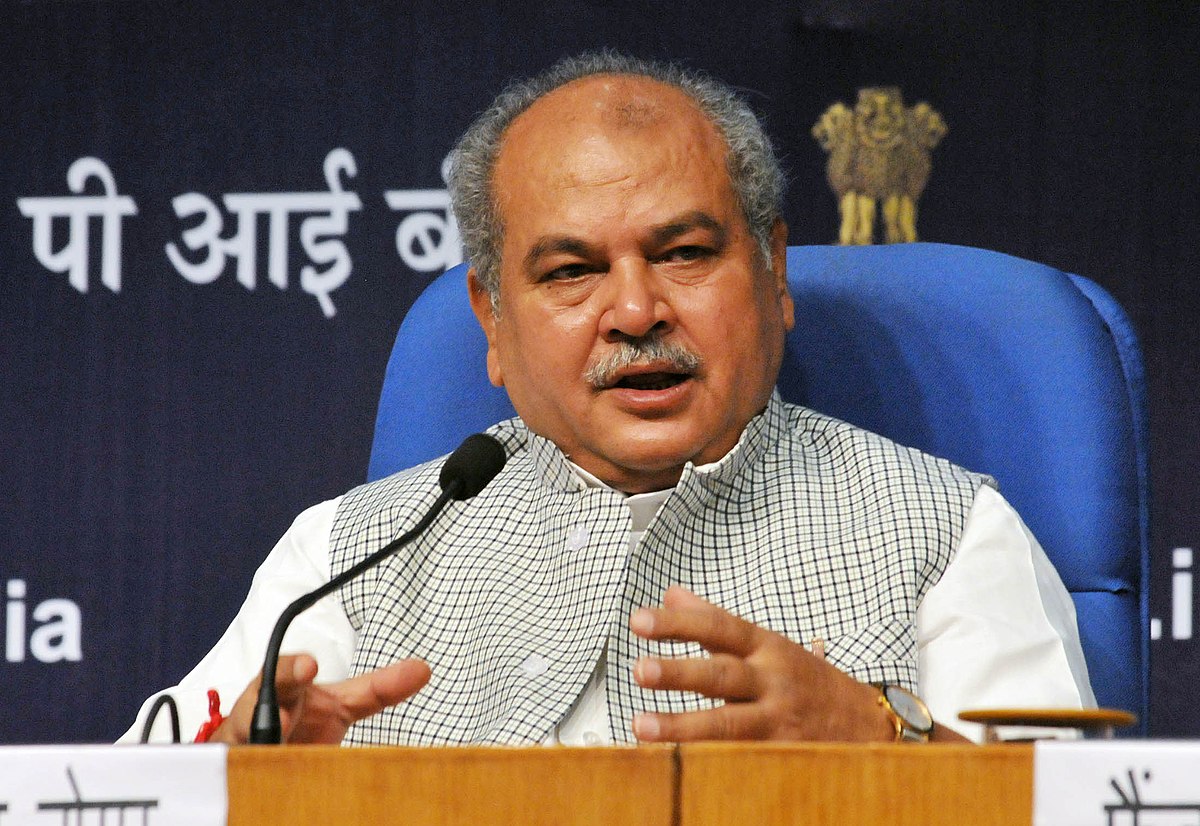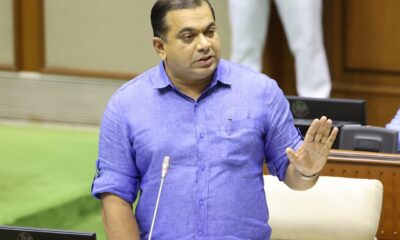Politics
Revitalizing of Agriculture Sector and Empowerment of Farmers: Narendra Singh Tomar, Minister, Agriculture and Farmers Welfare
Published
3 years agoon
By
goaplusnews
Agriculture is the backbone of the Indian economy. About 44 percent of our country’s labour force is connected to agriculture and it can be said that about 70 percent of the country’s population is dependent on agriculture. Yet it’s contribution to GDP is only 18 percent. To achieve the sustainable development goal of zero hunger and to meet nutritional needs of the population the agriculture sector needs positive change.
After independence, there was a felt need for reforms, in some directions reforms were undertaken but by and large decades old systems and structures continued. Successive governments due to political reasons and policy paralysis, left agriculture to the farmers and the result was that the farmers’ income did not keep pace with the cost of inputs.
During the past 7 years under the leadership and guidance of Prime Minister Shri Narendra Modi attempts have been made to revitalize agriculture and bring it in the main stream. Courageous reforms in the agriculture sector have led to positive results. Increase in agriculture production and improvement in the economic lot of the farmers are the fruits of their hard work. The future of agriculture looks brighter.
Through agricultural reformsinitiated under the leadership of Hon’ble Prime Minister, a foundation has been laid for the prosperity of Agriculture. Through the Farmers’ Produce Trade and Commerce (Promotion and Facilitation) Act, 2020, the farmer is free to sell his produce within the Mandi or outside it. Every producer in the country is allowed to sell his product anywhere but farmers were bound to sell their produce only in the mandi of their area. This step of the government fulfills the determination of ‘One Nation-One Market’ in the field of agriculture. Farmers also have the option of selling their produce in the mandis as before and the government is also strengthening the mandis.
One problem faced by the farmers was that they were not sure whether they would get the right price for what they were sowing or they would get a price which was less than the price of the inputs used. With an aim of giving the farmers the guarantee of a fair price before sowing, The Farmers (Empowerment and Protection) Agreement on Price Assurance and Farm Services Act, 2020 was introduced. Through contract farming, farmers will also be able to get modern resources and guidance for farming. I would like to clarify again that in contract farming, the agreement is only for the produce, not for the farmer’s land.Therefore, no one can snatch the farmer’s right over his own land.
For the upliftment of the agriculture sector, it wasfelt necessary that the budget for agriculture should increase so that more and more resources would be available to reform agriculture. The budget of the Agriculture Ministry has increased five and a half times in the last seven years. In 2013-14, the budget was only Rs.21933.50 crore, which was increased to Rs.1 lakh 23 thousand crore in 2021-22.
There was a need to formulate a strategy for agriculture which would help the farmer overcome and rise from his present circumstances and also help the farmer keeping his future in mind. Under the leadership of Prime Minister Shri Narendra Modi the government is mindful of these two aspects. When it comes to increasing the farmer’s income the first question that arises is that the farmer does not get the right and remunerative price for his produce. The government has made a historic increase in the Minimum Support Price (MSP) of Rabi, Kharif and other commercial crops.From 2018-19 onwards, MSP is being fixed by adding at least 50 percent profit on the cost of production. This has not only benefited the farmers selling the produce at MSP, but the prices have also increased comparatively in the market and the farmers have benefited. In comparison to the year 2013-14, the MSP of Paddy has increased by 48 percent and that of wheat has increased by about 44 percent in 2021-22. Our primary objective is to increase the area under pulses and oilseedsand that is why farmers have been given the benefit of a record increase in thesupport price of pulses and oilseeds. In the last five years, Rs 56,798 crore was spent on the procurement of pulses, which is 88 times more than the UPA regime, similarly Rs 25,503 crore was deposited in the account of farmers for the procurement of oilseeds, which is 18.23 times more than the UPA regime. The concept of ‘One Nation, One MSP, One DBT’ has played an important role in the direction of empowerment of farmers.
To empower farmers economically, the PM KisanSammanNidhi is a noteworthy and commendable attempt worth mentioning. Every year the farmers are given Rs. 6000 in 3 installments to fulfil their needs for seeds, manure and irrigation and the needs of the family. This campaign was started in 2019 and till now 11.36 crore farmer families have received an amount of Rs. 1,58,527 crore from this scheme.
Farmers in India are generally dependent on monsoon. While a good monsoon gives a bumper crop, there are times when drought results in less production. To deal with this uncertainty in agriculture, it has been necessary to bring the farmers under a security cover.Modifying the existing crop insurance schemes, Hon’ble Prime Minister Shri Narendra Modi has given a unique umbrella to the farmers in the form of Pradhan MantriFasalBimaYojana on 13 January 2016 which has removed many of the risks of farming.So far, farmers have paid a premium of Rs 21,484 crore under the Pradhan MantriFasalBimaYojana, while they have been paid Rs 99.04 thousand crore as claims.
A major problem of the farmer is the cost of agriculture and the inability to arrange funds on time. In such a situation, the farmer is often caught in the trap of debt by taking loan from the market. In the last 7 years, the government has worked to end this problem.Government of India gives 5 percent interest subsidy to farmers on crop loan, farmers have to pay only 4 percent interest.The total agricultural credit flow between 2007 and 2014 was Rs 32.57 lakh crore, which increased by 150 percent to Rs 81.57 lakh crore during 2014 to 2021.Till the year 2020-21, a total of 6.60 crore farmers have been provided Kisan Credit Cards.
The land holding of farmers in India is small. There are about 86 percent farmers who earn their livelihood by cultivating 2 hectares or less of land. Due to lack of resources, small farmers are neither able to do advanced farming nor are they able to join the market link to earn better profit. Farmer Producer Organization (FPO) is an innovative and concerted effort to help the farmers. Creating 10,000 new FPOs and enabling the small farmers to join them is the determination of the Prime Minister towards empowerment of farmers and their bright future. The government is spending Rs 6865 crore for the formation and promotion of these FPOs. Innovations through FPOs are emerging from across the country where small farmers are setting new examples of improved agriculture.
Essential infrastructure like warehouse, cold storage and processing units are situated away from the small farmers’ farms this comes in the way of their progress and value addition for their crops. To help the small farmers the Prime Minister has taken a historic step by setting up an Agriculture Infrastructure Fund of one lakh crore rupees under the Atmanirbhar Bharat Abhiyan.Through this fund, 3% interest subvention and agriculture guarantee assistance is being provided on loans up to Rs.2 crore on creation of post-harvest management infrastructure and community farm assets in villages.Within a year of the establishment of the Agricultural Infrastructure Fund,loans of Rs 4500 crore have been sanctioned for 6.5 thousand projects in the country so far.While the concept of ‘Farm to Fork’ is taking shape from the agri-infrastructure circle being built in the villages, along with the increased price of the produce to the farmers, opportunities are also being created for employment at the local level. I strongly believe that this innovative effort will add a new chapter to Indian agriculture in future.
India’s agricultural diversity and abundance of varieties is also one of our great strengths. Throughout the country, we have made attempts to strengthen agricultural resources. Establishment of Saffron Park in Jammu and Kashmir has worked to double the income of the farmers of the valley. The palm oil mission with an outlay of Rs. 11,040 crore will benefit farmers from the North-East States and Andamans and will help in self-sufficiency in edible oils. The income of farmers in tribal areas is being augmented by giving priority to the cultivation of coarse cereals.In the Gwalior-Chambal region of Madhya Pradesh and South Indian States, the work of increasing the income of farmers is being done through beekeeping.
Economic experts are of the strong opinion that the growth in agriculture sector in India at the rate of just 1 percent proves to be 3 times more profitable than non-agricultural sectors.This is the time when Indian agriculture is undergoing a new transformation. Among the agriculture based technology start-ups in the world, every ninth startup is from India. In the last decade, the youth of India have become increasingly inclined towards agriculture technology and Agri-business.Youth are once again joining agriculture, because now the risk is less and the profit is perceived.The agricultural reforms that were only talked about for seven decades have now been given concrete shape due to the determination of Prime Minister Shri Narendra Modi. We have moved ahead with the resolve to increase the income of the farmer, to get rid of middlemen and to establish Indian agriculture on a global scale. It is the nation’s resolve to make both agriculture and farmers AatmaNirbhar (self-reliant).
You may like
-


MLA Sankalp Amonkar Urges Action on Agriculture, Civil Supplies, and Handicrafts in Assembly Demands
-


CSC Diwas Celebrates 15 Years by Honoring VLE Excellence
-


MLA Borkar Flags Soaring Unemployment in Goa, Demands Overhaul of Employment Exchange Act
-


Manipal Hospital Performs Life-changing Restorative Surgery Saves Hand of a resident of Sawantwadi
-


The all-new BMW CE 04: First premium electric two-wheeler in India.
-


After Due Repairs, Public Toilets At Vagator will be Functional: TM Khaunte








